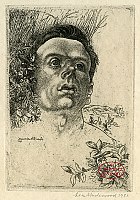 |
|
Leon Underwood1890 - 1975 |
|
|
Click on a picture for more details |
|
|
Leon Underwood was a hugely versatile artist and was a non-conformist pioneer in every field to which he turned his attention. He was an outstanding sculptor, painter, draughtsman, designer, etcher, engraver, teacher and writer on art. Henry Moore was considerably indebted to Leon Underwood in his sculpture, having at one time attended Underwood’s school. An intellectual who never sought fame, Leon Underwood once described the artist as “the sower who casts about him original thought, woven out of his intuition and imagination; when the conditions are right, germination takes place. The artist is the sower who at the harvest time is over the horizon – on his way to sow new ground”. He remained true to this philosophy throughout his life, always moving on to new ideas and new media once he had attained the high ambitions he set himself in every field. This approach applied as much to his intaglio etchings and engravings as to his other work, with almost all of his intaglio work being produced in a period of less than five years. Leon Underwood had first learned etching at the Royal College of Art under Sir Frank Short and his assistant, Constance M. Pott, in 1910, but soon developed a healthy dislike for Short’s taste. After some years studying art in Russia and Iceland he was invited by Sir William Rothenstein to return to the R.C.A. to teach drawing, and it was during his two years in this capacity that Leon Underwood returned to etching. His first known etching was of Ilfracombe in 1919. By 1921-22, with characteristic speed and vigour, he had reached the height of etching and drypoint technique, producing both his remarkable Granny Ashdown and his iconic Self-portrait in a Landscape within the year. These searching portraits were etched in characteristically decisive manner directly on to the plates - an approach typical of the remarkable ability which this gifted artist displayed, from the outset, in every process to which he turned his hand. Forever an experimenter, Leon Underwood’s brief foray into the realms of etching and intaglio engraving produced some of the finest printed works of his day – especially in the field of portraiture. In the brief period of only two or three years he left behind a remarkable and exceedingly rare body of prints which provide a marvellous representation of his truly innovative genius. Campbell Dodgson, then Keeper of Prints and Drawings at the British Museum, realised quickly that the works which Leon Underwood was producing at this time were of the greatest importance. Dodgson began to acquire them, both for himself and for the British Museum which, as a result, holds the finest public collection of the artist’s intaglio works. [more] |


